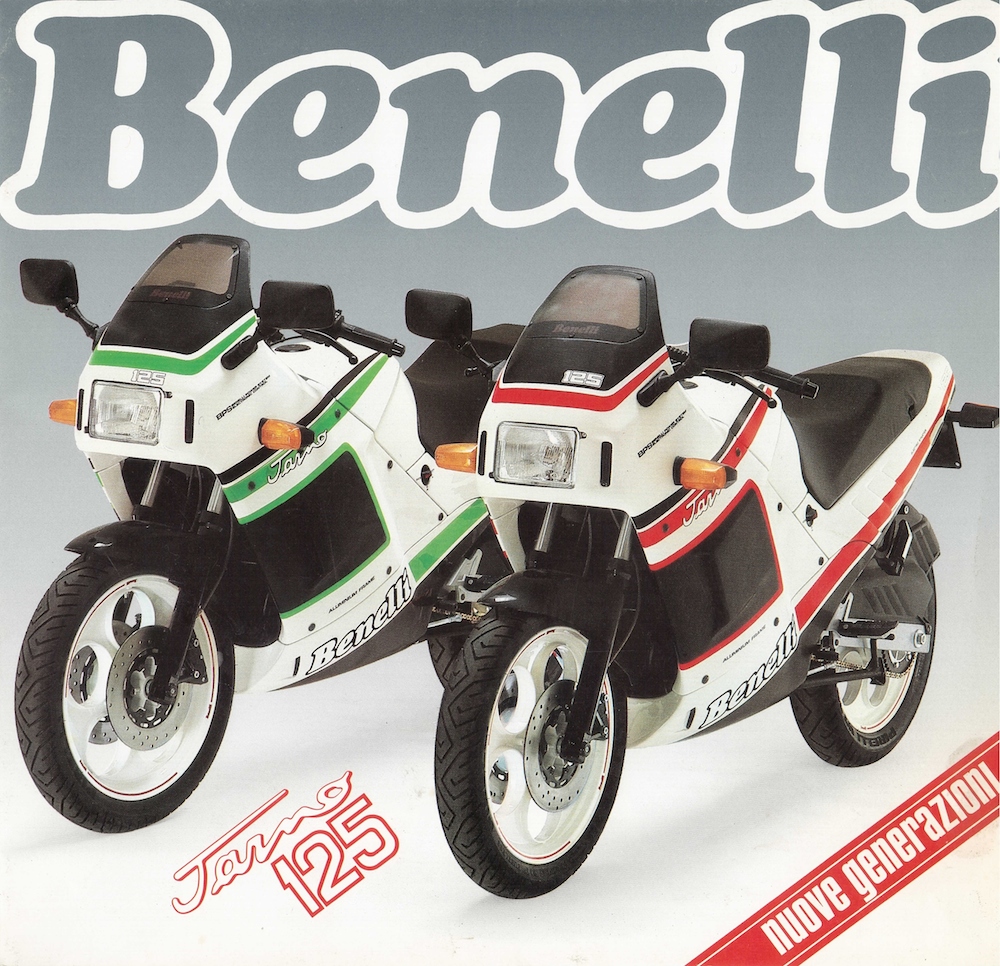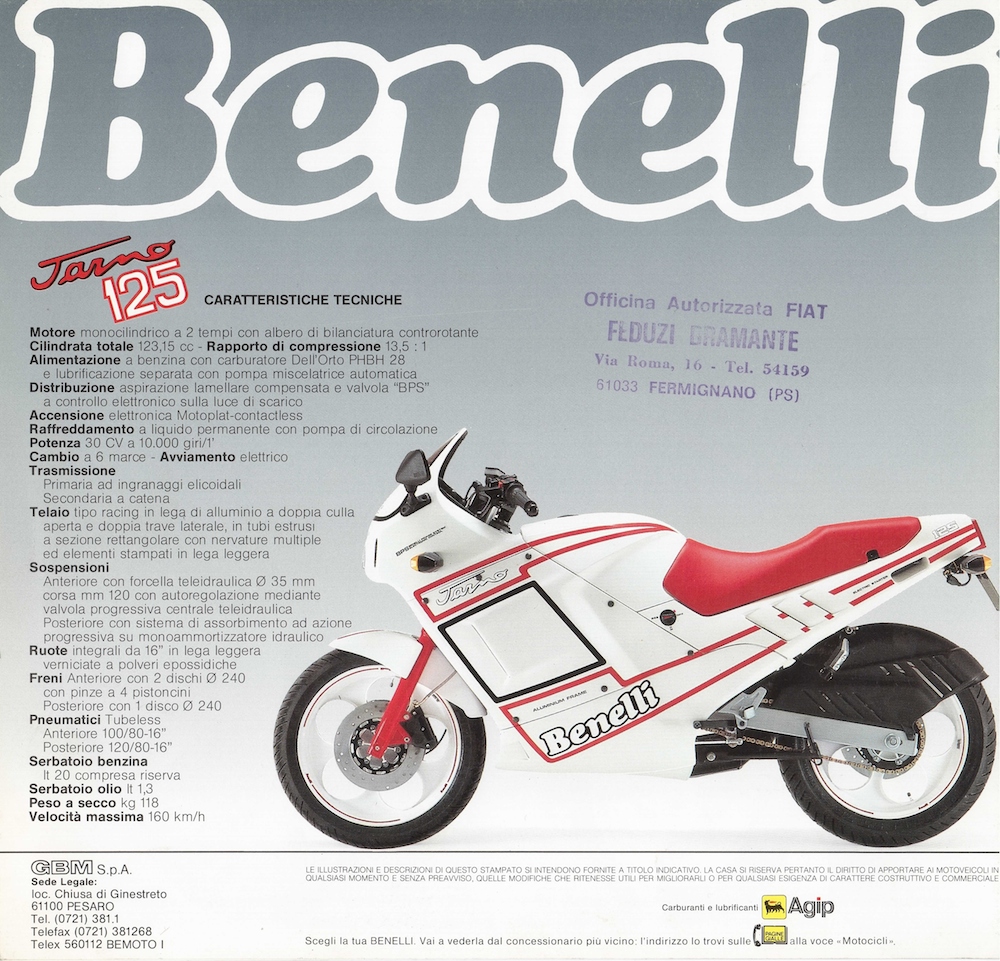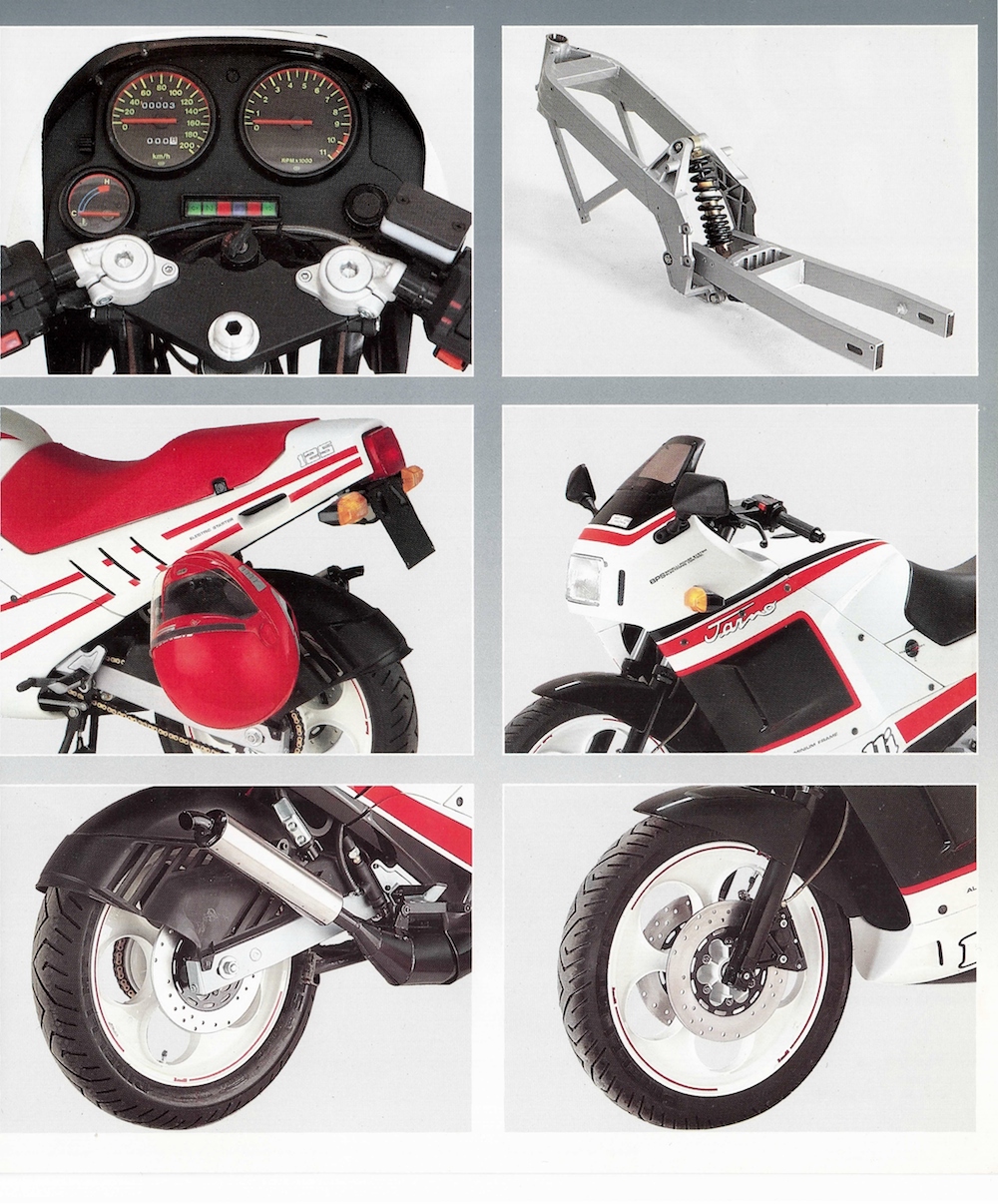La Benelli Jarno è l’unica 125 stradale raffreddata a liquido prodotta dalla casa pesarese. Per ora non tratteremo la forse più conosciuta 125 “2C” che come gli appassionati ricorderanno era raffreddata ad aria e quindi “figlia” degli anni 70, un periodo antecedente agli anni 80 e 90 a cui, invece, abbiamo dedicato 125stradali.com.
Presentata al Salone di Milano nel Novembre 1987 e commercializzata a partire da Giugno 1988, la Benelli Jarno, così chiamata in onore dello scomparso pilota finlandese Jarno Saarinen che aveva regalato alla Benelli diversi successi nei primi anni 70, è l’ultima moto stradale prodotta dalla gestione De Tomaso ed il canto del cigno per la casa pesarese.
Purtroppo a dotazioni moderne ed in linea con la concorrenza, come ad esempio un bel telaio in alluminio ed un motore completo di valvola allo scarico a controllo elettronico, si accompagnano le immancabili esigenze di riduzione dei costi di produzione che vedono l’adozione di certa componentistica ormai datata, come ad esempio le ruote lenticolari da 16”, che rendono la Jarno una 125 stradale già obsoleta alla nascita.
Citando il Registro storico Benelli: “Il declino è lento ma inesorabile. Nel 1988 la Benelli è in agonia: la produzione quasi azzerata, uffici tecnici e commerciali smantellati e circa 250 dipendenti in cassa integrazione. A salvare la gloriosa Casa pesarese da un futuro incerto è un ex operaio, l’industriale pesarese Giancarlo Selci, titolare del gruppo Biesse, che la rileva il 23 ottobre 1989 . Si riparte da zero puntando al settore ciclomotori, rinviando di qualche tempo gli ulteriori ambiziosi progetti e gli sforzi sono tutti concentrati sui nuovi modelli: Così, Devil, Scooty. Per la Benelli sembra tornato il sereno, ma dopo i primi momenti di euforia il futuro diviene nuovamente incerto.”
Il prezzo nel 1988 è di Lire 5.033.700 ed i colori inizialmente disponibili sono nero e bianco con, a scelta, inserti verdi o rossi e sella nera. L’ altra colorazione è bianco con inserti rossi e sella rossa. Tutte le colorazioni hanno i cerchi bianchi.
La Jarno quindi non è una cattiva moto, ma se paragonata alle fantastiche 125 stradali presentate nel 1988 da Aprilia conla Sintesi, Cagiva conla C10R, Gilera conla MX1 e Honda conla NSR-F, la Benelli non è semplicemente all’altezza. D’altronde, in un mercato spinto da giovani e volubili utenti (chi non lo è a 16 anni!) attentissimi alle novità che praticamente si susseguivano ogni sei mesi, presentare prodotti tecnologicamente e stilisticamente datati equivaleva alla morte commerciale.
La Jarno partecipa anche al campionato italiano Sport Production nella stagione ’88, ma senza ottenere grandi risultati e pur avendo conosciuto una limitata diffusione, rimane in produzione fino a inizio anni 90. Oggi la Jarno si prende forse la sua rivincita più importante cominciando ad interessare i collezionisti proprio per la sua scarsa diffusione e reperibilità.
La moto in breve
Paragonata alla concorrenza, la Jarno ha dimensioni piuttosto contenute e snelle rispetto alle altre 125 stradali che per dimensioni tendono a passare più per delle medie cilindrate.La Jarno è infatti caratterizzata da una linea molto semplice e senza fronzoli e sebbene abbia in dotazione una carenatura integrale che nasconde completamente alla vista telaio e propulsore, mantiene un aspetto particolarmente snello che nelle colorazioni bianco/verde e bianco/rosso risulta anche particolarmente elegante.
Il piccolo cupolino dotato di due piccole prese d’aria laterali si integra perfettamente con la carena che è composta da due pannelli laterali dotati di due ampie prese d’aria per facilitare il raffreddamento del motore e da due gusci inferiori che vanno a chiudere la parte inferiore lasciando uscire parte dell’espansione di scarico da un lato.
Il serbatoio in lamiera non è purtroppo ribaltabile, ma insieme ai fianchetti laterali va ad integrarsi magistralmente con la carena formando un unico insieme molto appagante alla vista. La sella si protende in avanti sui lati andando anch’essa a ben integrarsi con serbatoio e fianchetti e una volta rimossa da accesso alla cassa filtro aria e alla batteria collocati nella zona anteriore e ad un piccolo vano porta-attrezzi e documenti collocato nella parte posteriore. Veramente inconsueta, per non dire stupida, la posizione del tappo per l’olio del miscelatore che incredibilmente si trova sotto la strumentazione! Il serbatoio olio si trova quindi agganciato al telaio in prossimità del cannotto di sterzo e quindi nascosto dietro al cupolino.
La strumentazione CEV appositamente pensata per la Jarno risulta ben fatta anche se dal disegno datato, mentre i comandi elettrici sono i validi CEV comuni a quasi tutte le moto italiane prodotte nella seconda metà degli anni 80. I comandi a pedale sono ben fatti con le pedane pilota dotate di supporti in alluminio ben disegnati e le pedane passeggero dotate invece di più economici supporti in tubo di ferro, ma altrettanto ben disegnati. Da notare il parafangone posteriore che va a carenare parzialmente la ruota posteriore.
Ciclistica
Il telaio della Jarno è un doppio trave portante in alluminio scatolato. Il motore incastonato in questa struttura, viene sorretto anteriormente da due triangolature saldate alle travi principali. Il telaietto reggi sella è invece in tubi quadri di acciaio.
Le sospensioni prevedono all’anteriore una forcella teleidraulica classica da 35 mm prodotta dalla Foral ed al posteriore un monoammortizzatore idraulico ad azionamento progressivo regolabile nel precarico. Il forcellone posteriore è un classico tubi quadri in acciaio.
L’impianto frenante della Jarno rappresenta una nota diversa nel panorama delle 125 stradali e vede all’anteriore un doppio disco fisso da 240 mm servito da efficienti pinze a doppie pistoncino e tubazioni di tipo aeronautico di serie. Al retrotreno troviamo un disco fisso sempre da 240 mm servito da pinza a mono-pistoncino.
Il disegno delle ruote in lega è invece piuttosto datato così come le dimensioni che prevedono due ruote da 16”. I pneumatici Pirelli MT 75 utilizzati hanno le seguenti misure: 100/80-16 all’anteriore e 120/80-16 al posteriore.
Motore
Il propulsore della Jarno prodotto dalla Benelli racchiude le novità più importanti in tema di tecnica duetempistica ed è quindi dotato di valvola parzializzatrice allo scarico a controllo elettronico e naturalmente di ammissione lamellare, contralbero di bilanciamento ed avviamento elettrico. L’alimentazione è affidata ad un carburatore Dell’Orto PHBH 28 BS, mentre allo scarico troviamo un’espansione abbinata ad un finale in alluminio.
Il propulsore Benelli ha un carattere meno sportivo dei suoi concorrenti e a detta delle prove dell’epoca pare soffrire di vibrazioni agli alti regimi. Ad ogni modo i rilevamenti dell’epoca indicano prestazioni non troppo inferiori alla concorrenza. La Jarno rileva, infatti, una potenza massima alla ruota di 25,57 cv a 10500 giri ed una velocità massima di 154 km/h.




